初中英语教材七年级下册下第2单元第8课 Marco Polo and the Silk Road
- 格式:doc
- 大小:27.00 KB
- 文档页数:3
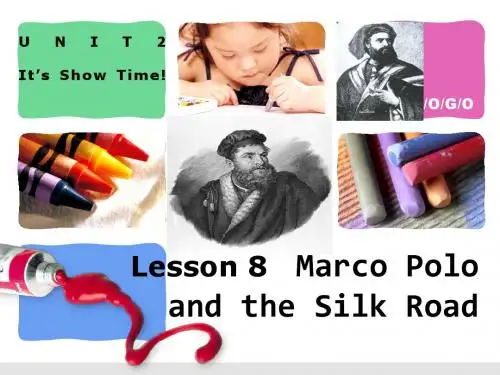
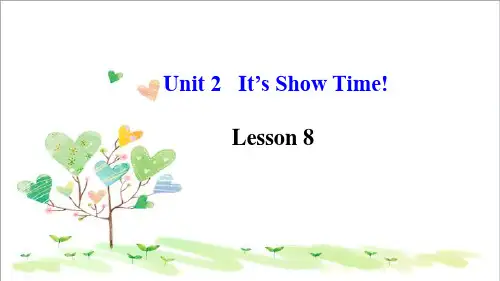
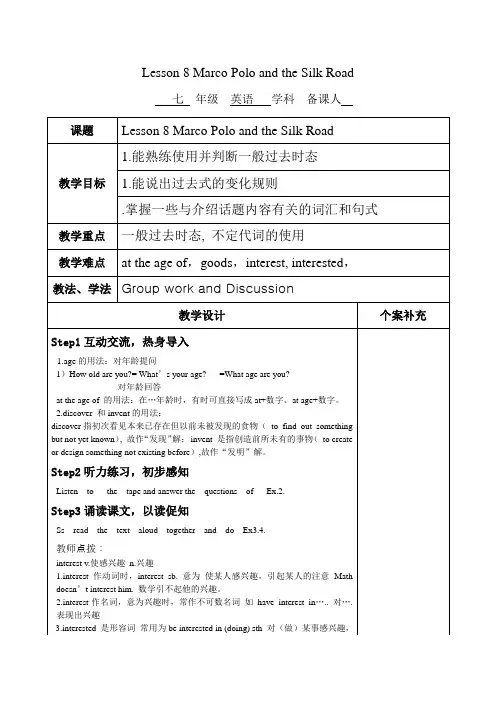

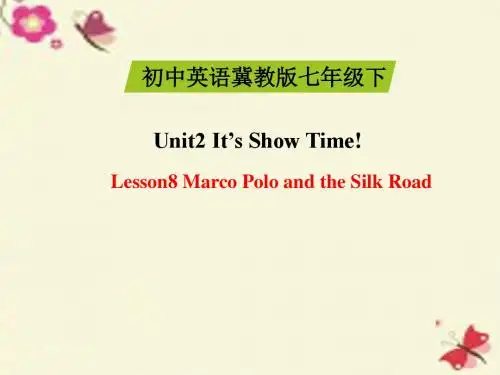
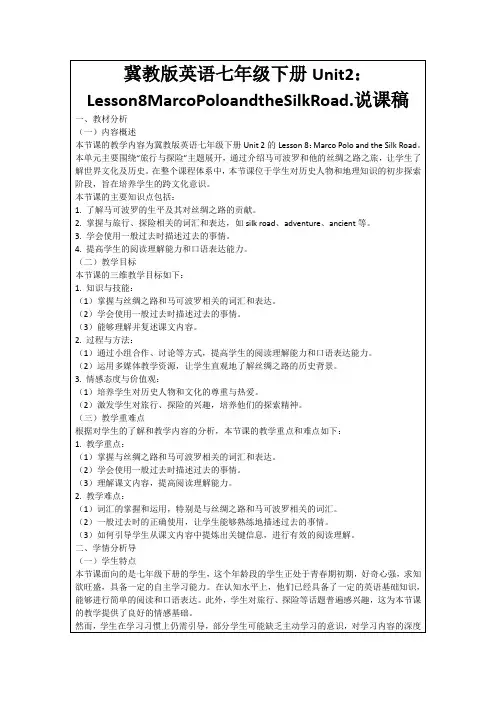
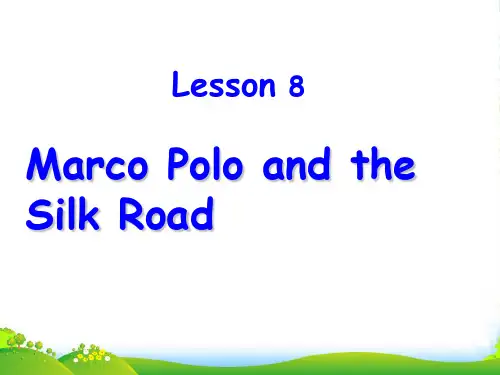
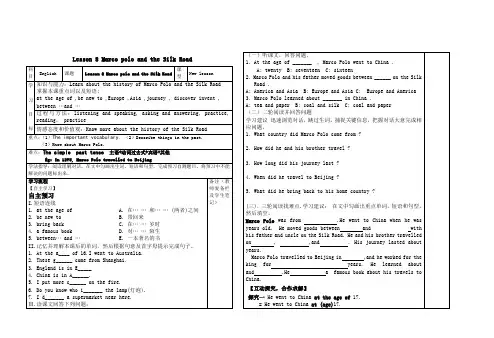
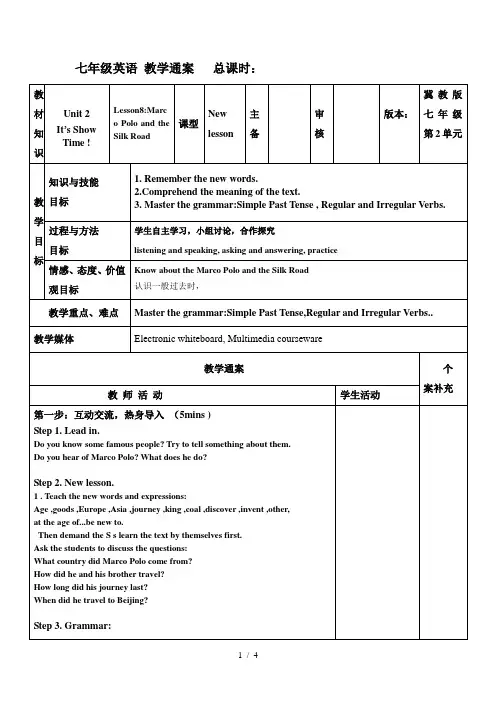
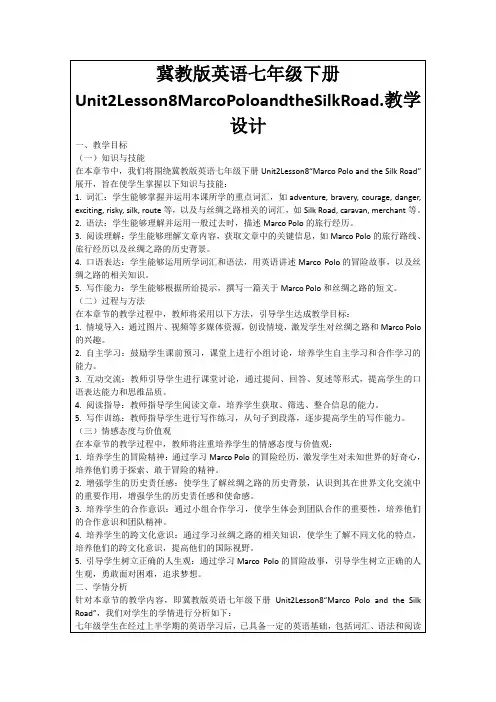
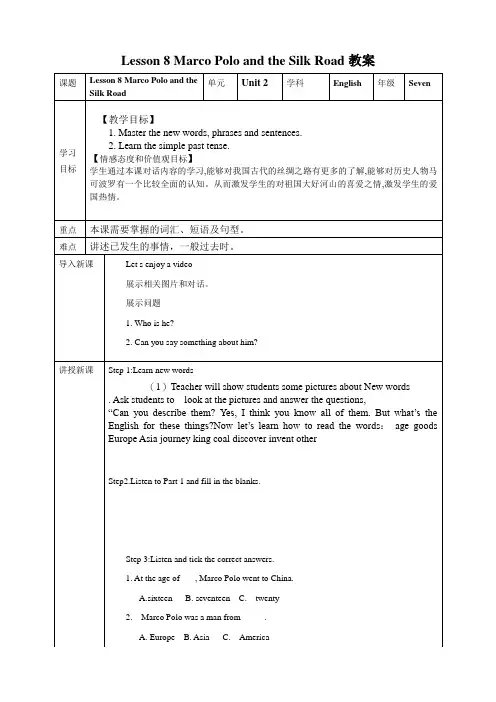
《Lesson 8 Marco Polo and the Silk Road》教学设计冀教衔接版七年级下册一.教学要求:(一)、知识与能力目标:1.掌握本课出现的单词和短语:age,Europe,Asia,journey,king,coal,discover,invent,other,be new to,at the age of2.能力目标:学习如何用英语介绍马可.波罗。
运用一般过去式,讲述曾经发生的事情。
(二)、过程与方法:通过对阅读性文本的改编,让学生用听说读写多种形式锻炼英语,从而更深入了解历史人物(三)、情感态度价值观目标:让学生了解马可.波罗和丝绸之路的关联,增强学生的民族自豪感和国际情怀。
二.教学重点:1. Know about Marco Polo.2. The past tense.三.教学难点:How to introduce a person in English .四、教学过程:Step 1:Lead in1. What is Jenny’s project about?设计思路:通过对上一课课文内容的回顾,引出今天所要学的课文,过渡自然。
Step 2:Present1.Show the picture of the new words.Teach the students to pronounce the new words.Teacher:Look at the pictue.Can you name the country?Help the students name the country or continent:Italy,Europe,Asia.Teacher:Ask and answerAsk two students to ask and answer the new words.2,Do some exercises about th words设计思路:充分运用多媒体,让丰富多彩的图片把今天所要接触到的人物,地理和生词全部体现出来,使学生在直观,生动的氛围中接受新的知识。
教学设计教学目标:学习目标:掌握单词age Europe Asia journey king coal discover invent other 及短语:at the age of between….and…be new to能力目标:运用过去时描述某事物培养学生的听说读写能力培养学生勇于用英语表达自己的能力情感目标:热爱祖国,激起对祖国的自豪感通过互助合作,增强学生的合作竞争意识教学重点:掌握重点单词、短语掌握并能运用一般过去时教学难点:能运用一般过去时课本中句子的理解教学过程:一.导入环节导入新课,板书课题导入语:look at the screen. Who is he? He is Marco Polo. he is from Italy . he is a famous businessman and a tourist., let’s learn about him. Another picture. What is it? It’s the Silk Road .where is it? It’s between Asia and Europe. We know ,Jenny is working on her project .what is her project? it’s Marco Polo and the Silk Road . today we will learn Lesson8 Marco Polo and the Silk Road, first let’s look at the learning aims二.出示学习目标学习目标:掌握单词age Europe Asia journey king coal discover invent other 及短语:at the age of between….and…be new to能力目标:运用过去时描述某事物培养学生的听说读写能力培养学生勇于用英语表达自己的能力情感目标:热爱祖国,激起对祖国的自豪感通过互助合作,增强学生的合作竞争意识三.Learn new words检测1.We know the lion is the k___ of all animals.2.Our j____ to Shanghai was very great.3.They d______ coal here many years ago四.Listen and answerListen and tick the correct answers.1. At the age of ___,Marco polo went to ChinaA twentyB seventeenC sixteen2. Marco polo learned about ___ in ChinaA tea and paperB coal and silkC coal and paper五. Reading :1. Fast readingRead the lesson quickly and answer the questions1.What country did Marco polo come from ?Marco polo came from Italy2.How long did his journey last ?Twenty years3.When did he travel to Beijing ?In 12752. read aloudRead the text aloud and discuss in groups , and translate the sentences.1). They moved goods between Europe and Asia on the Silk Road.2).He met the king and worked for him for 17years3).These things were new to Marco polo4).He brought some coal and paper back to Italy with him5).I hope to write a book like that someday3. read carefullyRead again ,talk about Marco polo .Find more information about him and present it to the class. You can make a dialogue.A: Do you know Marco Polo ?B:____A: Where was he from? B: ________A: How old was he when he came to China? B: ____________A: What did he do in China? B: ____A: What amazing things did he learn about in China? B: _________A :How long did he stay in China?B: _________六.合作探究Work in groups合作探究:找到问题答案,完成知识点.1.At the age of 17,he went to China 意思____________At the age of 意为_______ 翻与____________ 相同同义句转换:She began to learn English when he was five years oldShe began to learn English _________2.These things were new to Marco polo .翻译________________be new to 意为___________其中介词to 后_____跟或_____例The word is new to everyone 翻译______________I am new to the city . _____________________翻译3.I hope to write a book like that someday . 意思是______________________________ Hope 意为“希望”后面常接_________ 或_________Hope to do sth. 希望做某事She hopes ____ to China.A travelB travelsC to travelHope +(that) ...... 希望......I hope (that ) I’ll do better next time .hope sb. to do sth. (×) 这种句式是错误七.当堂检测Do some exercises当堂检测按要求做题1. I hope to write a book like that someday. (改为同义句)I hope that __ ____write a book like that someday.2. She read a book about Marco Polo at the age of ten. (改为同义句)She read a book about Marco Polo ___ ____ ______ten years old3.John is standing ____ Gina and Jim.A. atB. duringC. betweenD. in4.The place is ____ to me. It’s the first time I come here.A oldB newC sadD tired5.We all know that Bell ____ the telephone . It’s very useful todayA inventedB discoveredC foundD found out八.Summary What have you learnt in this class? We have learned Marco Polo, the Silk Road ,what important phrases? after we learned the lesson ,I want to say China is a great country with a long history , we are proud of our country九.Homework: 1. remember the words and phrasesin this lesson2. finish your exercise book板书设计Lesson8 Marco Polo and the Silk Roadbetween …and…. be new toAt the age of…. bring ….back to=when ..was\were…years old hope to dowork for hope that。
UNIT 2 It's Show TimeLesson 8 Marco Polo and the Silk Road教学目标【语言知识】(1) 学习和掌握本节课重点词汇。
(2) 学习和掌握作报告的相应格式和话术:Hello, everyone! My project is about….….Thank you!By: XXXDate: ….(3)掌握动词一般过去时的变化,尤其是动词的不规则变化,并能熟练使用。
【语言技能】通过本课的学习,培养学生综合运用语言的能力,有效提高学生听说读写能力。
【情感态度】通过本课的学习,开拓学生的视野,使他们积累更多的人文地理常识,培养学生的探索精神和热爱旅游的生活态度。
在老师和同学们的鼓励下,通过个人展示,可以培养学生的自信心,并能更好地调动孩子教学重难点【教学重点】1.掌握词汇:Italy, age, goods, Europe, Asia, journey, king, coal, discover, invent, other, hope, at the age of, be new to.2.能运用一般过去时熟练介绍名人的生平和重要成就。
【教学难点】1.熟练、正确地将动词原形转化为动词的一般过去时。
2.掌握动词的不规则变化。
教学步骤Step 1 Revision (about 5 min)1. Quick response: Teacher speaks Chinese meanings, and the students say out theEnglish words and expressions they learnt in last lesson.2. Translation: Translate the important sentence patterns one by one.3. Give students 1 minute to review the conversations they made yesterday, then invite some pairs to show their conversations.Step 2 Presentation (about 20 min)1. Divide students into 9 groups as usual, and six students for each. Teach the new words of this lesson.2. Teacher shows Marco Polo’s picture and makes students say something about him(Encourage them to try to use English as much as possible). Then, listen to the tape, and fill in the blanks.3. Let students read and analyze the passage about Marco Polo and the Silk Road in groups. Translate the passage and try to answer the following questions:(1). What country did Marco Polo come from?(2). How did he and his brother travel?(3). When did he travel to Peking?(4). How long did his journey last?(5). What did he bring back to his home country?4. Ask some students to answer the questions.5. Let one of groups translate the passage together.6. Make students analyze every important points of the passage, especially the Irregular Verbs. Teachers add more details.7. Group Contest: Let a group sums up the usage of Simple Past Tense. Then, pick up two groups to write the Irregular Verbs on the blackboard as much as they can. Award the first place, and make others read these words after them.Step 3 Practice (about 8 min)1. Teacher gives students a similar Chinese passage which is about a famous person,and let students translate in groups.2. Let students translate the passage sentence by sentence and then say it out after translation.Step 4 Production (about 5 min)Let others show pictures and introduce a famous person like that. They must useSimple Past Tense.Step 5 Summary (about 2 min)1. Let some students sum up what they have learnt today.They are expected to sum up the key words, phrases and sentence patterns. And they should sum up how to make a report.HomeworkWrite down their prepared introduction and finish the exercises after the passage.教学反思。
初中英语教材七年级下册下第2单元第8课Marco Polo and the Silk Road
各位老师下午好!
今天我说课的内容是初中英语教材七年级下册第二单元第八课。
这一课是阅读课文,阅读课教学是英语教学重要一环,如何培养学生良好阅读习惯和阅读方法,提高阅读能力,这正是素质教育中对英语教学的要求。
即要求学生尽可能的获取大量信息,开阔视野,提高兴趣,扩大词汇量,在丰富知识的同时提高应用语言的能力。
下面我将从以下几个方面阐述说课内容。
对教材的分析和理解:
本课属于记叙性人物传记,这一题材部分学生感兴趣,但缺乏阅读方面的技巧,因此需扩展相应知识,教授阅读方面技巧,从而提高阅读能力。
教学目标:
依据初中英语新课标对阅读课的要求,并根据素质教育中面向全体培养学生素质的要求,我为这一课确立三项目标:即知识目标、能力目标和德育目标。
1. 知识目标:帮助学生掌握三会、四会单词,同时让学生掌握故事涉及的人物,发生事件发生的起因、结果。
2. 能力目标:训练学生掌握良好的阅读习惯和阅读方法,即跳读、略读、速读和现时阅读等,同时注意开发学生记忆能力、观察能力、想象、比较和分析等多种能力。
3. 德育目标:渗透在日常生活中不怕困难,坚毅的思想品质。
教学重点:
因为是一篇阅读课,所以本课的重点在于培养和发展学生阅读能力,在有效时间内提高阅读效率,同时让学生在最短时间找到故事发生的背景和事件经过、高潮与结局,抓住主要内容。
教学难点:
让学生学会用动词过去式准确地表述在过去发生的事情,同时这也是教学大纲规定的初二上半学期教学重点。
教学手段:
多媒体辅助教学,有助于把学生引入到身临其境当中,增强故事真实感,激发学生兴趣,活跃课堂气氛,从而优化英语教学过程。
学法指导:
教会学生“三先三后”的学习方法,即先预习后学习,先看书后做题,先思考后提问。
本课重点在于最后一个方法---先思考后提问。
教学设计过程:
课堂的整体设计我遵循整体教学的思路,运用情景教学法和交际法,分五个主要步骤进行,即:导入, 展示, 巩固操练, 5分钟检测和布置作业。
第一,导入(pre-reading):(2’--3’)
一直以来,对于学生来说,最困难问题之一是背了单词就忘,即使记住单词,又存在不会应用的现象。
形成这种现象的主要原因在于缺少运用语言的环境与场景。
为此,如何让学生轻松自觉地回忆、掌握和运用单词呢?于是我想到了多媒体技术。
导入部分我设计了3个与教学内容相关的电影片段,在这边大家可以看到,通过投影仪上的生动画面,使学生回忆起当时的情景,并激发他们用尽可能多的词汇来描述事件发生的过程。
学生通过迅速联想和回忆,会编出若干个短句,如:“There were many people on board. Titanic hit the icebergs. Everyone tried to save their lives.
The man was too bad.等”,从而达到新课标要求下的知识目标一部分。
我会用2—3分钟时间。
第二,展示(while-reading):(15’)
这一部分既是培养学生良好阅读习惯,又是提高英语阅读能力的阶段,因此我将分二部分进行。
1. 扫读(skimming):
这一过程是让学生快速浏览全文,抓住文章主要内容,同时将为学生获取某种特定信息而阅读,只要求学生从材料中找到特定信息,领会主旨,可忽略大部分内容。
此处我根据加方校长Maggie编写的英语教师手册中故事曲线图(story graph)来设计的。
大家可以看到此处包括背景(即时间、地点与人物),高潮和结局。
让学生带着这些问题去阅读,认真思考,之后通过提问的方式找出正确答案。
从而体现出新课标要求下的对学生进行先思考后提问的学法指导。
2. 细读(scanning):
在领会了主旨,抓住文章大致内容之后,就应该要求学生再次对课文进行深入细致
阅读---细读。
我这样做的目的是为了指导学生理解文章的细节,段落大意,段与段之间的联系,使学生对篇章结构有更深层次的理解,为此设计了几项具体的操练形式。
首先由四人一组,分组讨论,给文章分段并归纳出段落大意,找出topic sentences。
这样以来不仅体现了学生之间合作与探索意识,同时又有助于培养学生分析归纳能力与合作解决问题能力。
然后是解释explaining:
这一部分主要是对学生在阅读中遇到的问题进行排疑解难,同时提出文章中的语法点,让学生学习语言知识。
设计步骤:重新回到文章当中,学生自主独立学习,找到并画出自己认为难懂、不会的词、短语与句子,提出问题,让其他学生帮助解决问题,如若有疑义,老师在进一步讲解。
这样做的目的是学生能做的让他们去做,让每一个学生都主动投入到课堂活动中来,始终坚持以学生为本,教师起主导作用这一理念。
第三,巩固操练(post-reading)(15’)
这一步我分两步进行:
a) 设置了竞赛----得苹果,分两组进行,是对动词过去式的理解和应用,让一组同学把另一组同学的句子在规定时间内,用过去式的形式正确表达出来,两组轮流转换。
通过这一形式,调动学生积极性,激励学生主动思考与分析。
从而化难为易,让学生进行归纳总结,如若不完整,老师再补充。
b) 设置了采访内容。
同样,当今英语教学过程已不仅是知识传授,应付考试过程,同时也是渗透思想、文化教育的过程。
我采取两位学生相互采访的形式,一位是CCTV—9记者,一位是当时获救的文章主人公Miss Evans, 就其学生之间语言的交流与应用可以进一步了解他们的世界观与人生观。
通过这种形式不单让学生获取某种知识,更是开阔了视野,激发学生兴趣并扩大了词汇量。
达到了新课改对阅读课教学的要求------即让学生自主应用英语进行实践。
第四,5分钟检测:(5’)
其主要考察不规则动词的过去式特殊形式和三个短语的用法,进一步巩固课上所学内容。
第五,布置作业:(2’)
这一环节既为这一课做好巩固,收尾,又为下节课做好铺垫和准备工作,故非常
重要。
其一,针对整个阅读课内容,首先让学生对文章进行缩写或改写,来培训学生组织语言、应用语言的综合能力。
其二,将此篇阅读文章改写成一个短剧,由小组合作完成,发挥学生的创造力和想象力,把语言切实应用到生活实际中来。
最后,预习下一课内
容。
板书设计:
我努力做到板书的清晰有序,安排合理。
在主板书处列出语言点,副板书位置列出三会、四会及扩展词汇,这样可以使学生清晰记在心理。